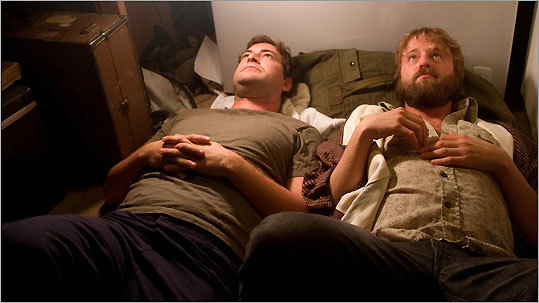Any fans of 1982's TRON who complain that its recent sequel, TRON: Legacy, is badly written, lacks depth, and only exists to showcase the latest advancements in movie-making technology have clearly not watched the original film in some time. TRON was a silly, written-by-committee corporate product that had nothing but then-state-of-the-art visual effects to justify its existence. It was a spectacle, and so is TRON: Legacy, but even more so.
Ignore the first 15 minutes or so. The film is actually pretty lame until Sam Flynn (son of Kevin, hero of the first movie) is sucked into the computer world of "The Grid", a virtual city created by his father. He's come in search of his forebear, who's been missing for the past 20 years.
Once we're in The Grid, the film finally starts in earnest and things hit the ground running. The digital environment is rendered with skill, sophistication, and imagination, and far surpasses the modest, blocky canyons of the first film. The Grid really has a bustling, believable life to it. It's almost as if this virtual world has been growing and flourishing on its own all this time.
Practically the minute he materializes in The Grid, Sam is captured and forced into gladiatorial combat against ferocious "programs", digital humanoids who exist only in this virtual reality. This battle sequence is exquisitely and excitingly pulled off. It follows a video game logic, as does the whole film from this point, that just didn't exist yet in 1982. The use of 3D space in particular is pretty clever.
After a sequence where the famous "lightcycles" make a magnificent return, Sam is suddenly rescued by the mysterious and beguiling Quorra, played with aplomb by Olivia Wilde, who's origin goes unexplained for some time. Quorra is the film's biggest surprise; Wilde renders her with such honesty, curiosity, and depth that its hard to believe she is only a computer program (or is she?). I won't say she belongs in a better movie, because she gives this dark, thinly written film some much needed heart. She is by far the most satisfying and fun character to watch.
Garrett Hedlund as Sam Flynn is really nothing special, just a more comatose version of Chris Pine's Kirk in Star Trek. Bruce Boxleitner is surprisingly effective. Reprising his role as both Alan, Kevin Flynn's best friend, and his digital alter ego, Tron, he has a kind of wistful, old soldier quality to him; the pain of Kevin's long absence is far more present in his eyes than in Sam's.
Jeff Bridges, who helped make the original TRON so much fun, has duel roles here, both as Clu, our villain who turns out to be something of a digital Hitler; and as Kevin Flynn himself, now grizzled, shamanistic, and somewhat bemused. In the latter role, Bridges is definitely in post-Dude mode; he even walks around in a bathrobe the whole time.
TRON: Legacy is unfailingly entertaining and unendingly gorgeous. Instead of relying entirely on blue screen, first-time director Joseph Kosinski opted to have physical sets built, and to clothe the actors in working lightsuits; these decisions help to give the look of the film some substance. Credit is also due to cinematographer Claudio Miranda, who manages to light faces in a unique and grounded way. Kosiniski and his team have finally done justice to Steven Lisberger's original vision of virtual reality, which was so far ahead of its time back in 1982.









































